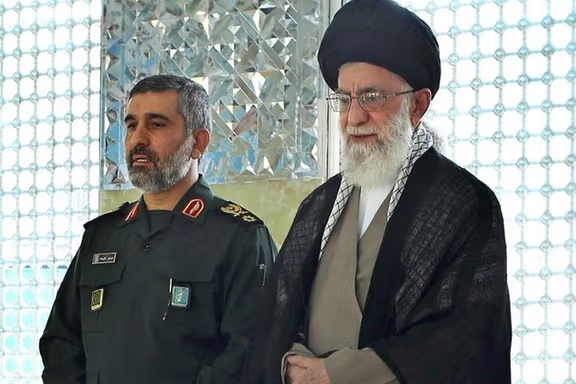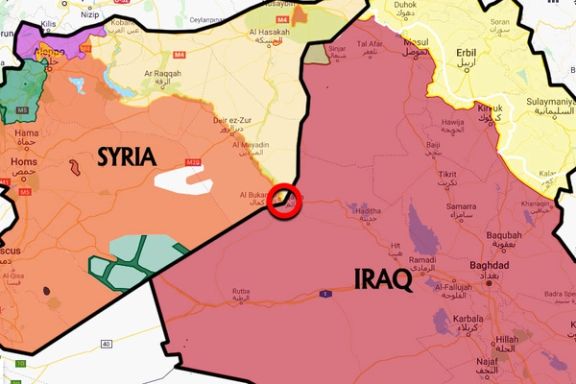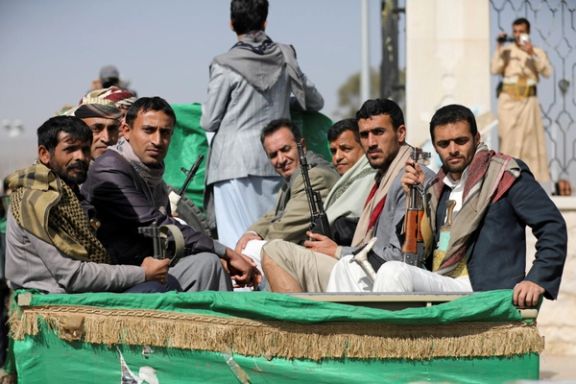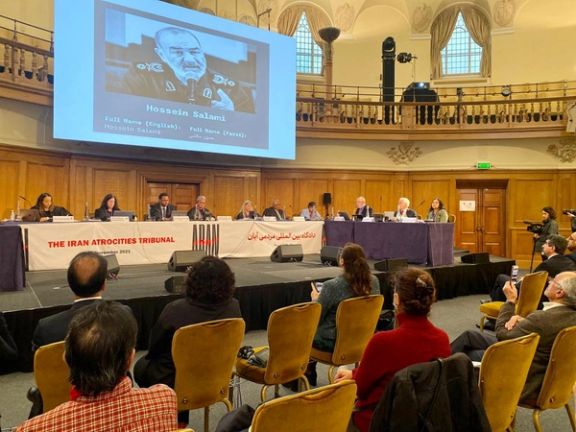'Don't Give Us Excuse To Destroy You', Iran General Tells Israel

If Israel gives Iran an excuse it will hasten its own destruction, the commander of Iran’s Aerospace Force said at a memorial ceremony in Tehran on Thursday.

If Israel gives Iran an excuse it will hasten its own destruction, the commander of Iran’s Aerospace Force said at a memorial ceremony in Tehran on Thursday.
General Amirali Hajizadeh said that Israeli officials are well aware they can start a conflict, but Iran will be the one to bring it to its conclusion, which is “the destruction of the Zionist regime”.
Hajizadeh was speaking at a ceremony to mark the death of Hassan Tehrani Moghaddam, one of Iran’s earliest missile architects, who was killed when a huge explosion rocked a missile base 30 miles from Tehran in November 2012.
Moghaddam was among 17 top IRGC officers killed that day, in what many believed was an operation by Israeli intelligence. The incident was so shocking that even Supreme Leader Ali Khamenei attended the funeral at the time.
Hajizadeh also praised the advances in Iran’s military drone program saying that “it has become a thorn in the eyes of the enemies.” He added that Iran’s military power has grown to the extent that adversaries are asking to negotiate over its missiles.
Besides Iran's nuclear program, the West and regional countries are also concerned about Tehran's ballistic missiles and want to limit the program.

Rights activists say the Iran Atrocities Tribunal is meant to bring the people's voice to the world and to make Islamic Republic authorities accountable.
The Iran Atrocities Tribunal convened in London Wednesday with testimonies from family members who sent recorded messages or testified via video on the alleged killing of their relative in protests in November 2019.
Regina Paulose, a member of the tribunal's counsel and an attorney who focuses on genocide and crimes against humanity, told Iran International that there was no “question of impunity” for Iran’s leaders. "The people's tribunal makes it known that… the leaders have to be accountable," she said.
While ‘atrocity’ is not a legal term, the tribunal follows the model of the Russell Tribunal on Palestine, which was held 2009 to 2014 to review alleged Israeli war crimes against Palestinians following the notion of ‘people’s tribunals’ advocated by British philosopher Bertrand Russell.
"When a similar tribunal was held for Palestine, [Iran's] Press TV was probably the only media outlet in the world that broadcast it live," journalist Mehdi Mahdavi-Azad said. "When such tribunals are concerning itself, they boycott them and make no mention at all.”

Mahboubeh Ramezanifard, mother of Pejman Gholipour, told the tribunal in a recorded message that she had kept her son’s “bloody clothes to show the world as evidence that my child was murdered.” Ramezanifard said her son’s jacket had “holes on both sides because he was shot with a live bullet."
In the afternoon session, United States-based opposition activist Masih Alinejad testified from her “own findings” that the Iranian authorities had made the families of those killed in the protests bury the corpses in remote places. Alinejad said this was “psychological torture.”
Alinejad also said “authorities” had threatened families not to talk to foreign media and has asked two for the cost of the bullet used to kill them. "The families believe there is no justice in Iran,” she said. “You can take your complaint against murderers to the murderers themselves.”
"We want this tribunal to hear the truth from witnesses," Shadi Sadr, a director of Justice for Iran, one of the tribunal organizers, told Iran International Wednesday.
Speaking via video to the tribunal, Nahid Shirbisheh said her son Pouya had been shot in the head while protesting peacefully alongside his mother in Karaj. She said hers was the first family to openly tell the world about “the atrocities of the Islamic Republic.”
"We didn't fear the consequences,” she said. “As a result, we have constantly been threatened and detained. Pouya's father is still in prison, in solitary confinement for seeking justice.”
The tribunal will in the next few days also hear the testimony of three Iranian police officers, a judicial official, and two doctors who tended to the wounded at their offices or homes to avoid arrest. These witnesses have travelled to London secretly.

A Syrian war monitor reported an air attack Wednesday on Iran-affiliated forces in eastern Syria followed by large columns of militia trucks coming to the area.
The Syrian Observatory for Human Rights (SOHR) based in London quoted its sources in Syria that unknown aircraft, possibly drones, attacked warehouses in al-Bukamal belonging to Iran-commanded militia forces in the early hours of Wednesday. The report said that the attack might have come from Israel, or the International Coalition headed by the United States.
SOHR said the “attacks destroyed the arms and ammunition warehouses and caused huge explosions”, but no casualties have been reported.
The Syrian government, which usually is quick to announce suspected Israeli attacks on Iran-affiliated targets, has not issued a statement.
SOHR further says that convoys of trucks came to the area on November 7 and also hours after Wednesday’s attack. Al-Bukamal ciry is near Syria’s border with Iraq from where shipments and fighters sent by Iran cross the border from Iraq. The area is known as a major military staging point for Iran.
In recent weeks Israel has continued attacks on Iranian targets in Syria, without any acknowledgement.

Assault rifles supplied by Iran to Yemen’s Houthis are finding their way across the Gulf of Aden to Somalia, a Geneva-based think tank reported Wednesday.
Iranian Fingerprint?, a report from Global Initiative Against Translational Organized Crime, was based on information from more than 400 weapons identified in 13 locations in Somalia over eight months and on weapons carried by dhows intercepted by naval vessels.
Report author Jay Bahadur, formerly coordinator of the United Nations Security Council monitoring group on Somalia and Eritrea, notes Iran’s consistent denial of supplying weapons to Ansar Allah, who since 2014 have battled a Saudi intervention, but writes that “a preponderance of evidence points to Iranian state supply.”
With many of the identified weapons – mainly Type 56-1 automatic rifles – having batched serial numbers, they are likely to originated with a single supplier, the report says. One dhow seized by the US navy had a digital positioning system that recorded visits to Iran − including an anchorage near the naval base at Jask port − and southern Yemen, where its home port was Mukalla, an arms hub.
The report concludes that weapons from “the Iran-Yemen arms trade are being trafficked onward into Somalia itself,” although buyers and sellers along the way were unclear. Demand in Somalia would come from many armed factions jostling for position ahead of Somalia’s presidential election due later this yearbut repeatedly postponed, with the mandates of all federal authorities expired. Somalia also has the militant Sunni groups al-Shabaab and the Islamic State group (Isis).
Neither Iran, Ansar Allah or Somalia have commented on the report, which claims to be the first research into the scale of illicit arms smuggling from Yemen into the Horn of Africa country.
Gateway For Illicit Weapons
The report cross-references serial numbers of Type 56-1 assault rifles, a Chinese made model similar to an AK47, either found in Somalia, seized in four naval operations, captured by anti-Houthi forces in Yemen, or in one instance held by an arms dealer in Sanaa. In particular, the report obtained an inventory of weapons seized by the USS Monterey in May 2021 in the Arabian Sea.
“The documented materiel included 38 Type 56-1 assault rifles…that had likely originated in Iranian arms shipments to the Houthis,” the report says. “The majority of Type 56-1 rifles documented in this study were found in Puntland, a semi-autonomous region in northern Somalia which has historically functioned as the gateway for illicit weapons into the country.” But the report “documented Type 56-1 rifles as far south in Somalia as Dolow, a town bordering Ethiopia…”
Iran is “only one party” sending arms to Yemen, the report says: “Arms and ammunition supplied to Yemeni actors by the Saudi Arabia, the UAE [United Arab Emirates], and even the United States have previously been diverted into illicit markets.”
The report notes that the spread of arms from the Yemen conflict has “potentially serious security implications” not just for Somalia, but for neighboring Ethiopia and Kenya, with Type 56-1 rifles “derived from the Iran–Yemen supply chain… documented in several towns bordering eastern Ethiopia and Kenya.” Ethiopia is locked in a civil war stemming from the crisis in Tigray.
While noting that the diversion of arms from the Yemen conflict has so far been confined to small arms, “the potential import of heavier weapons into Somalia – such as rocket-propelled grenades or anti-tank guided missiles…[could] enhance the capacity of al-Shabaab and ISIL [Isis] to challenge government forces, particularly in Puntland.”

Richard Ratcliffe is on a hunger strike outside the UK Foreign Office to protest the continued detention of his wife in Iran who is held virtually as a hostage.
On October 24, Richard Ratcliffe began a hunger strike outside the UK Foreign Office. The aim of the protest is to draw attention to the fact that his wife Nazanin Zaghari-Ratcliffe is still detained in Iran and unable to return to her family after five and a half years of separation.
Zaghari-Ratcliffe was convicted in an Iranian court of plotting against the Iranian regime, which she has always denied. She has been held in Iran since 2016 and is under house arrest following a second sentence and failed appeal.
As a psychologist with an interest in the effect of fasting on brain function, I have followed Ratcliffe’s hunger strike closely. Two UCL colleagues and I visited him on day 12 and made a short film (below) of our conversation. I spoke with him about the effect of his hunger strike on his mental state.
He described feeling somewhat slower in his thinking and perhaps less able to switch from one topic to another. But he still struck me as an impressive character, greeting all sorts of visitors – from an MP who dropped by to chat, to an Iranian woman who had been detained in the notorious prison where Zaghari-Ratcliffe spent four years. Although still calm, determined and dignified, it was clear that the lack of food was starting to affect his thinking. For example, his speech was noticeably slower than in previous media interviews.
Four days after our conversation, Ratcliffe was interviewed on Radio 4’s PM program. While still clearly passionate about his wife’s plight, he sounded increasingly fatigued and, at times, his speech was a little slurred.
Alongside the well-documented physical effects of going without food for this length of time, psychologists and neuroscientists have increasingly taken an interest in the psychological effect of such experiences.
Some aspects of thinking are surprisingly well preserved when people are in a state of starvation. An international review of short-term fasting studies did not find evidence that memory or reaction times were seriously affected.
But executive function, which includes planning, inhibition (holding back a response when it is inappropriate) and flexibility of thinking, seems to worsen when people are starved, although the effects depend on how few calories a person is consuming and for how long this restriction has lasted. Of course, the risk of increased rigidity in a hunger strike is that it becomes more difficult for the person to have the flexibility to decide when it is the right time to end their protest.
Studies of attention also suggest that this is also negatively affected by even short periods of fasting. However, a few studies have even suggested that repeated brief fasts may improve some aspects of concentration and memory and even reduce depressive symptoms. But, of course, this is quite different from the extended hunger strike that Ratcliffe has been undergoing.
Part of the difficulty in understanding the effect on Ratcliffe is that research studies have not asked people to starve for longer than about four days, because it would be unethical. The studies we reviewed in our recent paper looked at periods of fasting of between four hours and four days, so Ratcliffe is now in uncharted territory.
Those who fast for spiritual reasons commonly report altered states and feelings of being purified and recharged. A study by our group showed that both positive and negative emotions can increase following a period of fasting. While negative emotional states can include increased irritation, some people also reported an increased sense of achievement, reward, pride and control.
Of course, people’s emotional reactions are likely to depend on the reason they are not eating, whether this is for religious reasons, health reasons, for research or – as in Ratcliffe’s case – for ideological reasons. Ratcliffe’s frustration at his wife’s continuing detention may be enhanced by the hunger strike, but any sense of achievement and pride he may feel at doing something so difficult may be dampened by his discussions with the UK’s foreign secretary, Liz Truss, in which he reports that there was no change in the government’s approach to breaking the deadlock with Iran.
The-Conversation is provided by Reuters

On the eve of the second anniversary of Iran’s November 2019 protests, a People's Tribunal organized by human rights advocates has opened in London Wednesday.
The protests were the bloodiest in Iran’s history with security forces opening fire on demonstrators in many cities, killing hundreds.
On Wednesday, the counsel and panel of the three-day Iran Atrocities Tribunal heard the process and methodology used for gathering evidence and the testimonies of the witnesses and victims and security procedures to protect witnesses. It then proceeded to hearing the first witness, Amin Ansarifar, via video-link from Iran through a translator.
Ansarifar is testifying about the death of his son, Farzad who was a bystander shot in Behbahan in southern Iran. "The autopsy showed that my son had been shot in the head with a Kalashnikov," he said adding that the weapon is a standard issue used by all security forces including the Revolutionary Guards (IRGC) and the police.
He also said the family had been told by the authorities not to publicize the death of his son and that he filed a complaint with the authorities to no avail. Ansarifard said family members including his daughter and brother have been harassed and prosecuted for propaganda against the regime and talking to foreign-based media.
After hearing the evidence and deliberating, the panel of the Tribunal will determine whether crimes under international law have been committed by Iranian state forces and paramilitaries during the protests. The panel will also identify the perpetrators in its final judgment.
The tribunal − also known as Aban Tribunal after the Iranian calendar month of Aban − was established on the first anniversary of the November 2019 protests by the London-based Justice for Iran, the Oslo-based Iran Human Rights (IHR), and the international anti-capital punishment organization Ensemble Contre la Peine de Mort (Together Against the Death Penalty) to investigate “atrocities” and “human rights violations by Iran” during the protests that left hundreds dead. The verdicts of theTribunal will be symbolic.
Organizers say the findings of rigorous investigations conducted by the UN Special Rapporteur on the Situation Of Human Rights in Iran, the UN Secretary General, and organizations such as Amnesty International, Human Rights Watch, Justice for Iran and Iran Human Rights, provide "paramount evidence on grave human rights violations" committed by state forces during the protests and the absolute impunity the perpetrators have enjoyed.
The tribunal will hear and examine evidence and testimonies on crimes against humanity, extrajudicial killings and executions, torture, rape of prisoners, and harassment of the families of the victims which organizers say all indicate an extensive systematic state policy behind suppressing protesters. The Iranian Constitution recognizes the right to peaceful protests.
In March the Tribunal wrote to Iran’s ambassador in The Hague, Alireza Kazemi Gharibadi, to inform him that it had “charged” Supreme Leader Ali Khamenei, President Hassan Rouhani and former Chief Justice and current President, Ebrahim Raeesi, with gross human rights violations and crimes against humanity related to protests in 2019.
According to the group’s statement issued on March 3, the letter called on the named individuals including Revolutionary Guards (IRGC) and police commanders to attend hearings organized by the Tribunal which had originally been due in July to answer allegations made against them.
Iran has not officially announced figures for deaths or arrests, nor put anyone on trial for killing protesters, but has prosecuted and passed heavy sentences including the death penalty on protesters on charges including “assembly and collusion against the regime.” Officials, including Interior Minister have put the number at over 200.
Amnesty International has reported the killing of at least 304 protesters including at least 23 minors. Reuters on December 23, 2019 claimed three sources close to Khamenei’s inner circle had confirmed he had grown impatient and ordered officials to stop the protests. According to Reuters about 1,500 people were killed in the two weeks after November 15.